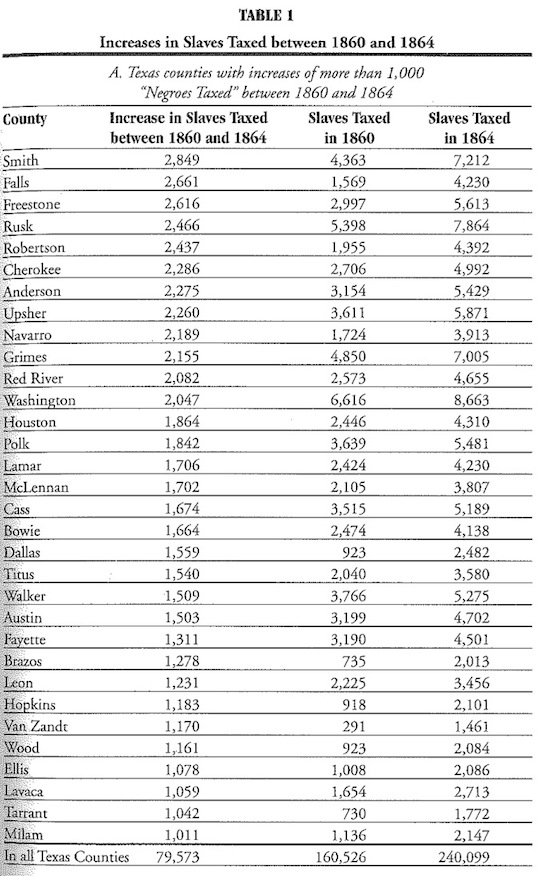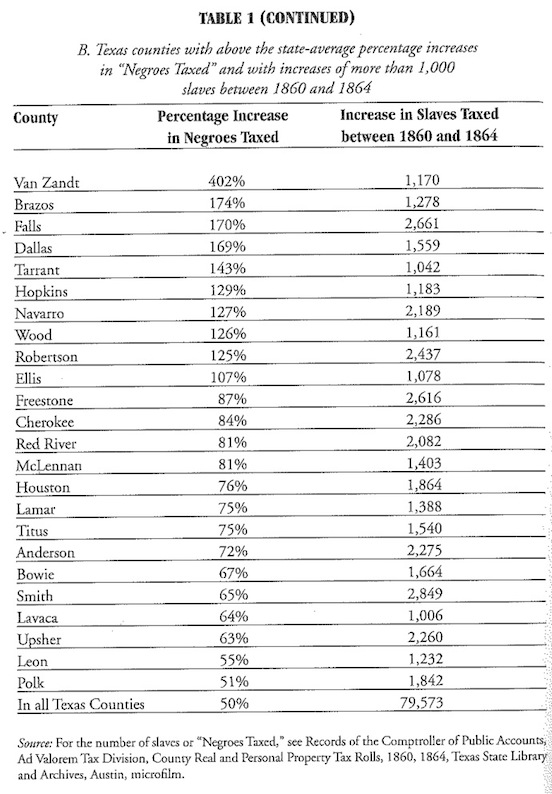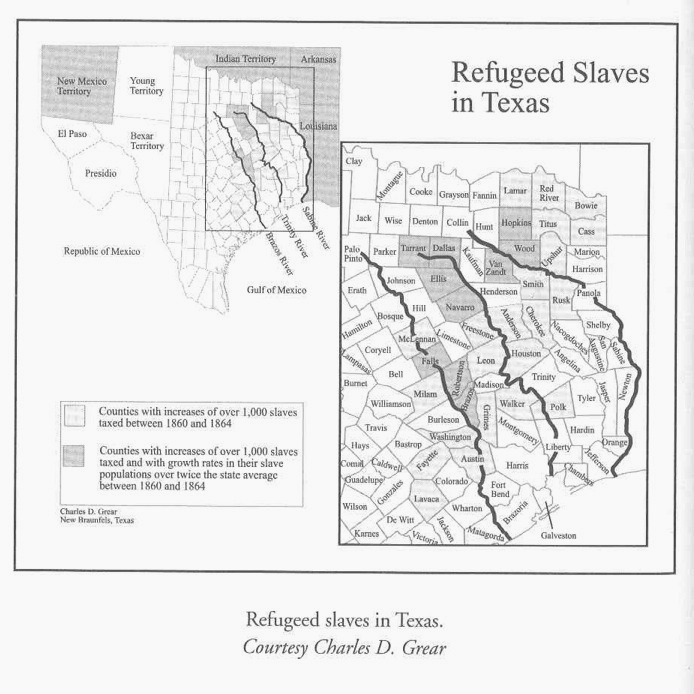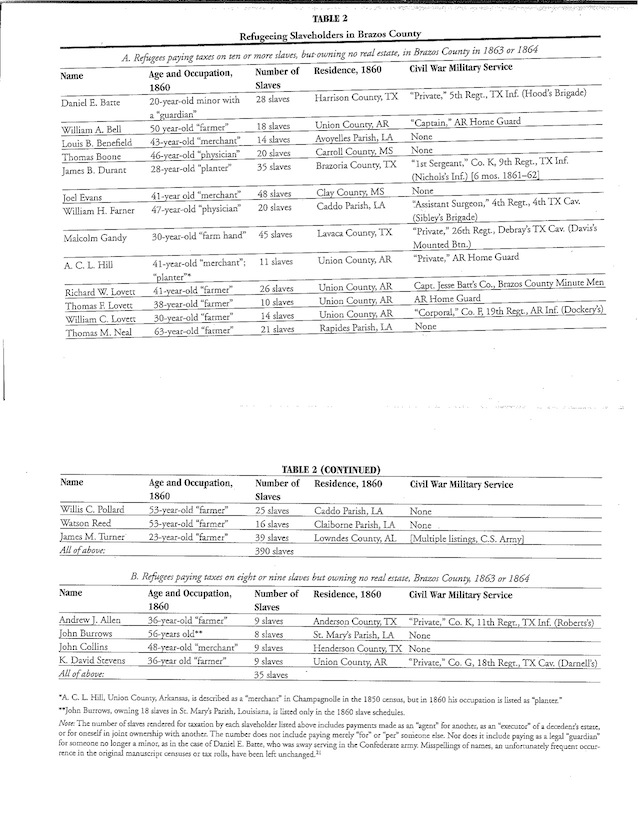baum2008
@InCollection{ baum2008,
author = {Dale Baum},
editor = {Charles D. Grear},
title = {Slaves Taken to {T}exas for Safekeeping during the {C}ivil {W}ar},
booktitle = {The Fate of Texas: The Civil War and the Lone Star State},
address = {Fayetteville},
publisher = {University of Arkansas Press},
pages = {83--103},
year = 2008,
}Summary
The chapter argues that Shiloh, the surrender of New Orleans, and U.S. naval operations on the Mississippi River “dramatically increased the flow of Confederate refugees into Texas” (83), especially from Louisiana, Arkansas and Mississippi. Baum revises the estimates in campbell1989 about the number of refugeed slaves brought into Texas during the war and also identifies those counties along the Sabine, Trinity, and Brazos rivers where they were concentrated. He also assembles a list of some of the largest refugee slaveholders. His major finding is that refugeed slaves “could have without difficulty reached more than 50,000, and of this number about 60 percent probably remained in the state during the immediate postwar years” (84).
Revising the Numbers
Changing the Assumed Natural Rate of Increase
Assuming the 11.1 percent increase in “slaves rendered for taxation from 1858 (144,463) to 1860 (160,526) was more typical of late antebellum trends than the jump from 1860 to 1862 (which was inflated by secession crisis and the slaves of Missouri refugees who arrived by January 1, 1862), Baum thinks the number of refugeed slaves was higher than the 32,000 estimated by campbell1989.
A first wave of refugees arrived from Missouri even before Battle of Bull Run, when about ninety slaves from Missouri were brought to Dallas. “Additional newspaper accounts confirmed that the roads behind the group were ‘lined with emigrants’” (86). Their arrival means it would be a mistake to use the 1860 to 1862 rate of increase as a benchmark by which to measure the 1862 to 1864 increase in “slaves rendered for taxation.”
“Texas had about 42,000 more slaves taxed in 1864 than it would have had if the rates of increase between 1860 and 1862 and then again between 1862 and 1864 had mirrored the late antebellum 1858–60 pace” (86).
Taking into Account Non-Assessed Slaves
The number may well have been closer to 47,800 assuming that tax assessors forgave certain classes of slaves (incapacitated, elderly, newborn, runaway slaves) that they normally did, as indicated by the usual gap between the tax rolls and the federal census. That gap may even have been greater during the war because of:
- escapes to Mexico, which led the Houston Telegraph to warn against sending even “trusty negroes” to Matamoros
- Confederate-allied “removed” Indian tribes who may have taken slaves to the frontier
- many eastern slaveholders who may have removed to the western part of the state (in Young and Bexar), beyond the reach of tax assessors (86–87)
If any “nonrefugeed” slaves were “left off the tax rolls” for reasons like these, “then their drag on the growth rate of slaves taxed must be offset by a proportional boost in any estimation of refugeed slaves” (87).
Most of all, there was a surge of slaves brought in the spring of 1864 because of Red River Campaign. “By the beginning of April, refugees from the areas around Alexandria in central Louisiana had poured into the northwestern city of Shreveport, the temporary Confederate state capital and gateway to Texas” (87). And all of these slaves wouldn’t have been assessed for tax purposes until first day of the next year. Moreover, Baum cites anecdotal evidence that slaves continued coming even in early 1865, and from farther away than LA.
All of these considerations should “conservatively add at least 3,000 or 4,000 slaves to the 47,800 estimate,” so that the total number could “have easily reached 51,000” (88). That could be higher if a death rate was factored in.
Counties Most Affected
Tax-roll data alone doesn’t “put into proper context the relative effect from one place to another of refugeed slaves” (88). To focus the discussion, Baum only focuses on counties likely to have seen an influx. Baum provides a table showing “Texas Counties with Increases of More than 1,000 ‘Negroes Taxed’ between 1860 and 1864.”
Table 1, Part A, p. 89

And then within that list, Baum zeroes in on those counties with “above the state-average percentage increases”:
Table 1, Part B, p. 90

His major finding is that all of the counties but one in the top ten of this list bordered the Sabine, Trinity, or Brazos rivers, as indicated by Map 1 on p. 82.
Map

p. 88: “Three regions thus emerge as the temporary residencies of many slaveholding refugees whose bondsmen composed comparatively high percentages of the wartime increases in the respective county slave populations”:
- “adjacent counties on the central part of the Brazos River southeast of Waco and northwest of Navasota, ranging from Falls to the north and Brazos to the south, with Robertson sandwiched between”
- “contiguous counties along the upper Trinity River”
- Wood and Van Zandt counties, with neighboring Hopkins County
Reactions to Refugees
In Houston at the end of 1862, reports were published describing “the roads leading from Louisiana” full of refugees. “If only inches of newspaper columns are counted, then the largest coverage of what was called ‘the exodus of Texas’ occurred predictably in 1863” (p. 91). Also cites observations of Caleb Goldsmith Forshey. Good quotes about the roads being crowded.
Some contemporary reactions were exaggerated, among which Baum lists Magruder’s 150,000 claim.
In 1863, concerns were raised about the use of refugeed slaves to work on fortifications. Baum mentions the brief conflict between Kirby Smith and Magruder over whether recently arrived slaveholders should be exempted from the impressment orders. Other local newspapers were concerned about refugeed slaves being unsupervised, including those of a “Dr. Blackman” in Smith County (92). In general, however, “the records of the proceedings of the commissioners’ courts in counties affected most by refugeed slaves are remarkably silent about the newcomers causing any threats to law and order” (93). Refugeed slaves did, however, increase “economic class tensions within white society” (93), as poor whites objected to large slaveholders who had run away from the front. Anti-secessionist slaveholders were under the most suspicion, particularly in Robertson County.
Sample of Refugee Slaveholders
Combining census data with tax rolls, Baum uses Brazos County to identify likely refugees. “Slaveholders not residing in Brazos County before the war, but who subsequently paid taxes there in 1863 or 1864 on at least 10 or more slaves but not on any land, meet the criterion for being almost certainly medium or large slaveholders seeking greater protection for slave property” (94). There are 16 masters (owning 390 slaves) fitting this description in Brazos, most of whom were from other parts of Texas:
Table 2: Large Refugee Slaveholders in Brazos County (pp. 95–96)

This data also suggests that slaveholders moved slaves from coastal counties near suspected points of federal invasion. The parishes in Louisiana turned up in this inventory include Claiborne Parish, Rapides Parish, Avoyelles Parish, and Caddo Parish (Shreveport). There is detailed information about the geographical origins of a few of the planters listed in the table. Only one of the refugees returned to prewar residence, and that one came from Lavaca County.
Postwar Mobility
Many of the refugeed slaves brought to Brazos remained, even though many also returned to reunite with families. Based on some conjectural suppositions, Baum estimates that “there is a chance that about 40 percent of the slaves taken to Texas for safekeeping subsequently left the state, or conversely, about 31,000 former refugeed slaves from other ex-Confederate states still remained in the Lone Star State at the outset of the brief years of Republican Party ascendancy” (p. 102).
Future Research
Tracking correlations between Reconstruction and refugeed slaves might show that “refugeed slaves … influenced in measurable ways the course of grassroots Reconstruction.”
Looking into documents buried in courthouse records might also turn up more evidence about refugeed slaves. (The case in Robertson county described above was found in the “Minutes of the District Court” in Robertson County.
